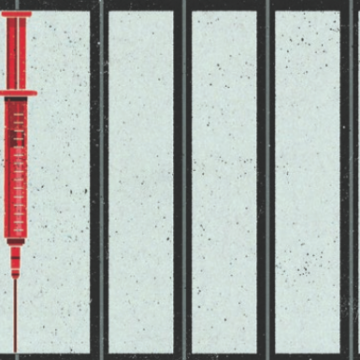For the better part of 2008, as part of my work at the Canadian HIV/AIDS Legal Network, I interviewed 50 people across Canada who had spent time in prison. Most had used drugs when they were behind bars, and their stories were hauntingly similar: they grew up in a difficult home alongside family members who struggled with addiction. Because drugs were readily available, many started using them at an early age. And this often led them to take part in activities that landed them in prison.
Once they were behind bars, they didn’t stop taking drugs. Everyone I spoke to said that injection drug use in prison is rampant. They’re right. According to a 2007 survey by the Correctional Service of Canada, 17 percent of male prisoners and 14 percent of female prisoners had injected drugs in prison. How is that possible? Correctional officers, family members and other prisoners smuggle substances like heroin, codeine and morphine into prison.
But sterile needles are hard to come by behind bars, so prisoners turn to riskier alternatives. They might reuse a diabetic inmate’s insulin needle or construct one out of a pen. Then they share them, leading many to become infected with blood-borne infections like HIV and hepatitis C.
 There is now an HIV and hepatitis C epidemic in Canadian prisons. About 19 percent of federal prisoners are infected with hepatitis C and about one percent have HIV. But there is a research-backed solution: distribute sterile needles to prisoners. Prisons could do so through their health unit, a dispensing machine or a prisoner who’s been trained to educate others about how to safely inject drugs. Countless studies have shown that such programs decrease the spread of HIV and hepatitis C. Better still, they reduce the number of in-prison overdoses and increase referrals to drug-treatment programs.
There is now an HIV and hepatitis C epidemic in Canadian prisons. About 19 percent of federal prisoners are infected with hepatitis C and about one percent have HIV. But there is a research-backed solution: distribute sterile needles to prisoners. Prisons could do so through their health unit, a dispensing machine or a prisoner who’s been trained to educate others about how to safely inject drugs. Countless studies have shown that such programs decrease the spread of HIV and hepatitis C. Better still, they reduce the number of in-prison overdoses and increase referrals to drug-treatment programs.
The Canadian government knows this. It’s even funded a few of the best studies on the subject. But despite the powerful data, no prison in Canada permits the operation of needle and syringe programs.
Under the previous federal government, this was no surprise. It was clear that waging a costly (and failed) “war on drugs” trumped evidence, public health and human rights.
That’s why, in 2012, after almost 20 years of frustrated attempts by the Canadian HIV/AIDS Legal Network and other groups to convince the federal government to implement needle and syringe programs, we took legal action. We teamed up with former prisoner Steve Simons (who contracted hepatitis C in prison) and three other HIV organizations to sue the federal government for failing to provide prisoners with the same needle and syringe access that’s existed outside prison for almost three decades. That lawsuit continues to wind its way through court.
Meanwhile, we have a new government in power. But in the year since the Liberals won the last election, there has been no change. It’s true that this government has shown more openness to putting syringe programs in place, but that has so far amounted to nothing.
Openness is not enough. We will continue to press the federal government to uphold the rights of prisoners by providing them with sterile injection equipment. Far too many people have already become needlessly infected with HIV and hepatitis C as a result of the government’s decades-long stalling.
We need to replace ideology with evidence. We need to answer this question once and for all: do we care about the health of our prisoners, or don’t we?
 Sandra Ka Hon Chu is a lawyer and the director of research and advocacy at the Canadian HIV/AIDS Legal Network, where she has worked for almost 10 years.
Sandra Ka Hon Chu is a lawyer and the director of research and advocacy at the Canadian HIV/AIDS Legal Network, where she has worked for almost 10 years.
 This story is from our Winter 2016 issue.
This story is from our Winter 2016 issue.
Illustration by Richard Mia


